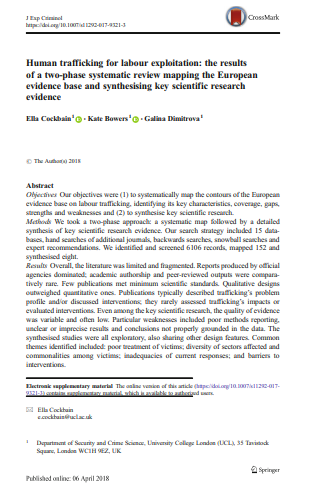Abstract
Objectives
The article objectives were (1) to systematically map the contours of the European evidence base on labour trafficking, identifying its key characteristics, coverage, gaps, strengths and weaknesses and (2) to synthesise key scientific research.
Methods
The authors took a two-phase approach: a systematic map followed by a detailed synthesis of key scientific research evidence. Their search strategy included 15 databases, hand searches of additional journals, backwards searches, snowball searches and expert recommendations. The authors identified and screened 6106 records, mapped 152 and synthesised eight.
Results
Overall, the literature was limited and fragmented. Reports produced by official agencies dominated; academic authorship and peer-reviewed outputs were comparatively rare. Few publications met minimum scientific standards. Qualitative designs outweighed quantitative ones. Publications typically described trafficking’s problem profile and/or discussed interventions; they rarely assessed trafficking’s impacts or evaluated interventions. Even among the key scientific research, the quality of evidence was variable and often low. Particular weaknesses included poor methods reporting, unclear or imprecise results and conclusions not properly grounded in the data. The synthesised studies were all exploratory, also sharing other design features. Common themes identified included: poor treatment of victims; diversity of sectors affected and commonalities among victims; inadequacies of current responses; and barriers to interventions.
Conclusions
There is a lack of high-quality studies into European labour trafficking. Methodological opacity, insufficient rigour and publication in non-indexed locations impede the identification, assessment and synthesis of evidence. Adherence to higher reporting standards would further the field’s development and particular research gaps should be addressed.

